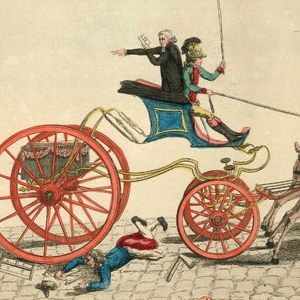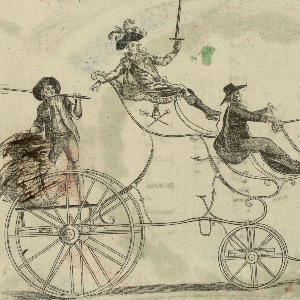Revolutions
Babeuf’s Trial
Long after sans–culotte influence on the government had waned, social conflicts continued to drive some revolutionary events.

Inside a Revolutionary Committee during the Reign of Terror
The extremely respectful view of sans–culotte militancy is evident in this image, engraved by the French Revolutionary sculptor Berthault and based on a painting by Fragonard, the son of the famous old regime painter.
Manifesto of the Enragés
Jacques Roux, a former priest turned radical French revolutionary, became the leading voice for a group known as the "Enraged," because they expressed constant anger at the unfairness shown toward the ordinary, poor people who made up the bulk of the patriotic citizenry and whose plight Roux dema

The Good Sans–Culotte
Reflecting values of the French Revolution, Male and female sans–culottes were supposed to embody frugality, thrift, hard work, and, above all, honest devotion—whether to pets, the nation, or fellow comrades.

Abuses to Suppress
This French Revolution era print depicts the Third Estate—represented by the peasant at the rear of the chariot, the worker leading the horse, and the merchant driving—delivering to the National Assembly a petition listing "abuses" to be remedied.
Populace Awake
In the view of the most radical commentators, such as those writing for the newspaper Révolutions de Paris, the French Revolution had to be the work of more than just the deputies of the National Assembly; it had to be an effort of the common people.
Beware the Wealthy Bourgeoisie
The term "bourgeoisie" had many meanings in eighteenth–century France, from the most literal sense of "citizens of a city" to a more sociological meaning of talented and cultivated members of the Third Estate. Some eighteenth–century writers also used the term to refer to merchants.

Departure of the Three Orders for Versailles
Although 14 July 1790 was a high point in the aspiration for unity during the French Revolution, the preparation for the Estates–General set the stage for later problems.
Three Cahiers from Orléans
The cahiers de doléances ("list of grievances") drawn up by each assembly in choosing deputies to the Estates–General are the best available source of the thoughts of the French population on the eve of the French Revolution.
Cahiers—A Parish Cahier
The cahiers de doléances ["lists of grievances"] drawn up by each assembly in choosing deputies to the Estates–General are the best available source of the thoughts of the French population on the eve of the Revolution.